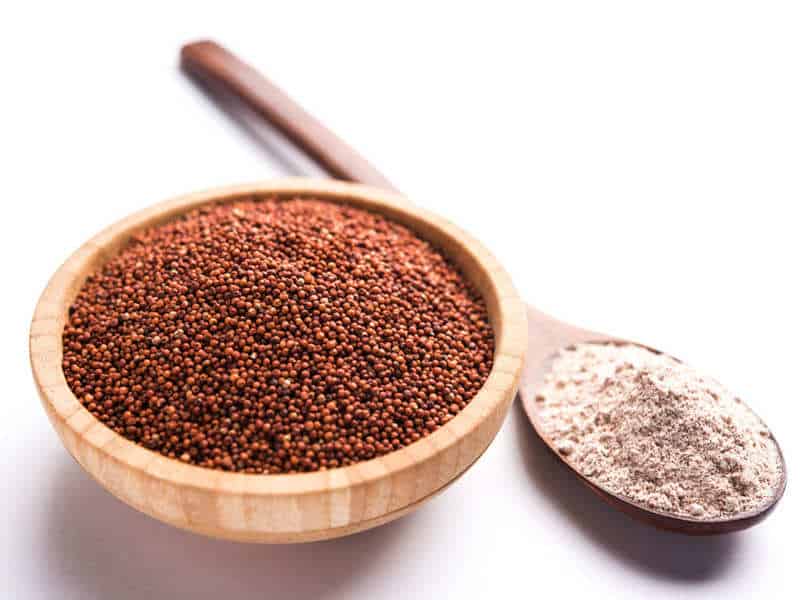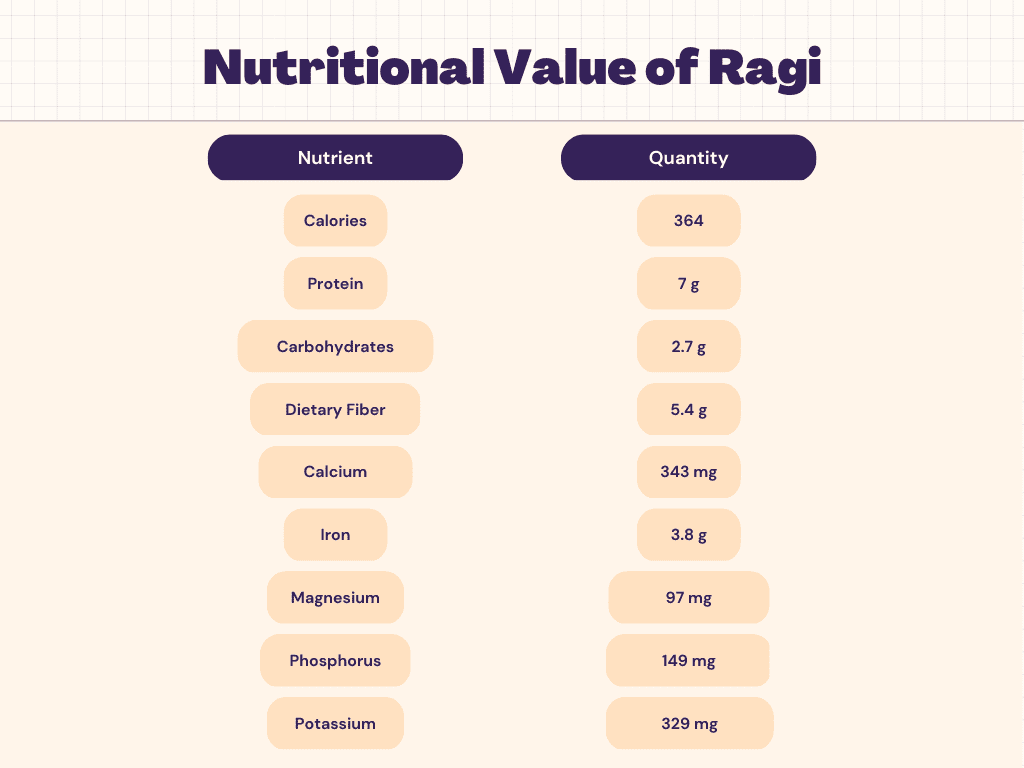Ragi, also known as finger millet, is a staple grain in many countries and is considered a nutritious food source due to its high calorie, protein, and carbohydrate content. One serving of ragi can provide a significant amount of essential nutrients, making it an ideal food for those looking to improve their overall health and wellness. In addition to being a rich source of energy, ragi is also low in fat and gluten-free, making it a popular choice for individuals with dietary restrictions. Whether consumed as porridge, flour, or in other forms, ragi offers numerous health benefits and is a valuable addition to any diet.
Nutritional Value of Ragi
Nutritional Facts of Ragi
Carbs In Ragi
Ragi is a rich source of carbohydrates, with approximately 74 grams of carbohydrates present in every 100 grams of grain. These carbohydrates provide a significant amount of energy for the body, making ragi a popular food for individuals who engage in physically demanding activities. Additionally, the type of carbohydrates found in ragi is complex carbohydrates, which are slowly absorbed and metabolized by the body, providing a sustained release of energy. This makes ragi an ideal food for individuals looking to maintain stable blood sugar levels. Moreover, the high fiber content of ragi helps to slow down the digestion and absorption of carbohydrates, further contributing to sustained energy levels.
Protein In Ragi
Ragi is a good source of protein, containing approximately 7 grams of protein in every 100 grams of grain. This makes it a valuable food for vegetarians and vegans who may not have access to animal-based protein sources. The protein in ragi is considered to be of high quality as it contains essential amino acids that are necessary for the proper functioning of the body. The protein content of ragi can help in building and repairing body tissues, making it a crucial component for overall health and wellness. Additionally, the high protein content in ragi can help to keep you feeling full for a longer period of time, making it a great food for weight management. Overall, incorporating ragi into your diet can provide a range of health benefits and contribute to your daily protein requirements.
Health Benefits Of Ragi
Ragi has been shown to have several health benefits, particularly for individuals with Polycystic Ovary Syndrome (PCOS), thyroid issues, diabetes, and those looking to lose weight:
- PCOS: Ragi is a low glycemic index food, which means it has a slow and gradual effect on blood sugar levels. This can help regulate menstrual cycles and manage symptoms of PCOS. Check our PCOS Plans here.
- Thyroid: Ragi is rich in magnesium, which has been shown to play a role in regulating thyroid function. Additionally, the high fiber content in ragi can help to regulate the absorption of hormones that are important for proper thyroid function. Check our Thyroid Plans here.
- Diabetes: As a low glycemic index food, ragi can help regulate blood sugar levels for individuals with diabetes. Additionally, the high fiber content in ragi can help to slow down the digestion and absorption of carbohydrates, further contributing to stable blood sugar levels. Check our Diabetes Plans here.
- Weight Loss: Ragi is a low-calorie food that is high in fiber and protein, making it an ideal food for weight loss. The high fiber content can help you feel full for a longer period of time, reducing overall calorie intake and promoting weight loss. Additionally, the protein in ragi can help to build and repair body tissues, while also providing sustained energy levels throughout the day. Check our Weight Loss Plans here.
Vitamins & Minerals in Ragi
Ragi is a rich source of several essential vitamins and minerals, including:
- Calcium: Ragi is an excellent source of calcium, with 343 milligrams of calcium present in every 100 grams of grain. Calcium is important for strong bones and teeth.
- Iron: Ragi contains 3.8 milligrams of iron per 100 grams, making it a good source of this essential mineral. Iron is necessary for the formation of red blood cells and the transportation of oxygen in the body.
- Magnesium: Ragi is a rich source of magnesium, containing 97 milligrams of this mineral in every 100 grams of grain. Magnesium is important for muscle and nerve function, and can also help regulate blood pressure and support a healthy immune system.
- Phosphorus: Ragi contains 149 milligrams of phosphorus in every 100 grams, making it a good source of this mineral. Phosphorus is important for strong bones and teeth, and also plays a role in energy metabolism and the functioning of the kidneys.
- Potassium: Ragi contains 329 milligrams of potassium in every 100 grams, making it a good source of this important mineral. Potassium is important for heart and muscle function, and can also help regulate fluid balance in the body.
In addition to these vitamins and minerals, ragi also contain small amounts of other essential nutrients, including vitamin B complex and essential amino acids.
The Bottom Line
Ragi is a nutritious grain that is rich in carbohydrates, protein, fiber, calcium, iron, magnesium, phosphorus, and potassium. It is a low glycemic index food and has a slow and gradual effect on blood sugar levels, making it beneficial for individuals with diabetes. Additionally, it has numerous health benefits for individuals with Polycystic Ovary Syndrome (PCOS), thyroid issues, and those looking to lose weight. The high fiber content in ragi can help regulate digestion, the high protein content can help build and repair body tissues, and the calcium and iron content can support strong bones and teeth. Incorporating ragi into a balanced and varied diet can provide numerous health benefits and contribute to daily nutritional requirements.
Faqs
How much Ragi can I eat in a day?
The amount of Ragi (also known as finger millet) that you can eat in a day depends on several factors, including your age, sex, height, weight, and level of physical activity. However, as a general guideline, it is recommended to limit your intake of any one food to moderate amounts as part of a balanced diet. Eating too much of any food, including Ragi, can lead to weight gain and other health problems. It’s best to speak to a healthcare professional for personalized advice on how much Ragi and other foods you should eat based on your individual needs.
Should I eat Ragi before or after exercise?
It’s a good idea to eat Ragi, or any other food, before exercising if you need the energy to fuel your workout. Eating a light meal or snack containing carbohydrates, such as Ragi, about 30 minutes to an hour before exercising can help you maintain your energy levels during the workout.
On the other hand, if your workout is intense and lasts for an extended period of time, you may benefit from eating a meal containing carbohydrates after exercising to replenish your glycogen stores and help your muscles recover.
What are the benefits of Ragi?
Ragi, also known as Finger Millet, is a nutritious grain that offers several health benefits, including:
- High in Fiber: Ragi is rich in fiber, which promotes digestive health and reduces the risk of heart disease and diabetes.
- Rich in Minerals: It is an excellent source of calcium, iron, and magnesium, essential for strong bones, healthy blood, and nerve function.
- Gluten-free: Ragi is gluten-free, making it a suitable grain for people with celiac disease or gluten intolerance.
- Promotes Weight Loss: Ragi’s low glycemic index helps to regulate insulin levels, preventing overeating and promoting weight loss.
- Good Source of Protein: Ragi is an excellent source of plant-based protein, making it a good alternative for vegans and vegetarians.
- Helps Lower Cholesterol: The high fiber content in ragi helps to lower cholesterol levels and reduce the risk of heart disease.
- Promotes Heart Health: The magnesium in ragi helps to maintain a healthy heart rhythm, lower blood pressure, and reduce the risk of heart disease.
What is the best time to eat Ragi?
There is no specific best time to eat Ragi as it can be consumed at any time of the day. However, it is often recommended to include Ragi in one’s diet for breakfast, as it provides a slow release of energy throughout the day, keeping you feeling full and satisfied for longer. Ragi porridge, for example, is a popular breakfast option in many regions.
Ragi can also be incorporated into other meals, such as lunch or dinner, in the form of Ragi flour used to make rotis, and dosa, or as a thickener in soups and stews. The key is to make sure you are including Ragi in your diet regularly to receive its health benefits.










